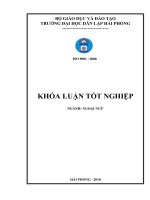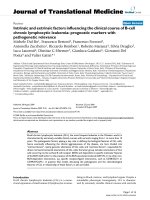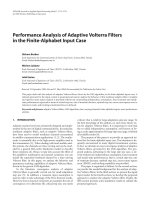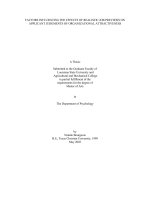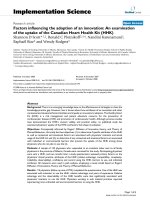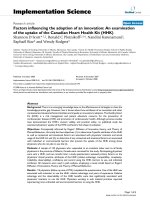Analysis of factors influencing the profitability of listed commercial banks in kenya
Bạn đang xem bản rút gọn của tài liệu. Xem và tải ngay bản đầy đủ của tài liệu tại đây (671.53 KB, 75 trang )
ANALYSIS OF FACTORS INFLUENCING THE PROFITABILITY OF LISTED
COMMERCIAL BANKS IN KENYA
BY
OMWANDO ROBERT
1022602
A RESEARCH PROJECT SUBMITTED IN PARTIAL FULFILMENT OF THE
REQUIREMENT FOR THE AWARD OF THE DEGREE OF MASTER OF BUSINESS
ADMINISTRATION (MBA) – FINANCE OPTION
GRADUATE BUSINESS SCHOOL
FACULTY OF COMMERCE
THE CATHOLIC UNIVERSITY OF EASTERN AFRICA.
JULY, 2017
ii
ACKNOWLEDGEMENT
I am thankful and grateful to the almighty God for his strength, grace and protection throughout
my studies.
The success and completion of this work has been the effort of many and in a special way I
thank my parents Mr. and Mrs. Patrick and Victoria Aminga for their full support throught my
studies and my project; to my siblings Priscah, Violet, Emmah and Haron Aminga for the
encouragement.
My special thanks also goes to my supervisors Prof. Alloys Ayako and Dr. Thomas Githui for
their comments, encouragement, Patience and tireless guidance which have been of great
assistance throughout my research.
I also recognize the good supportive team I have had with all my friends.
I recognize the efforts and dedication of my lectures throughout my studies.
I humbly extend my gratitude and appreciation to you all. I feel privileged to share the success
of my work with you all.
iii
DEDICATION
To my parents; Patrick and Victoria Aminga who are my daily reminders that I can be
whatever I want to be in this life. May the almighty always protect and bless you.
iv
TABLE OF CONTENTS
DECLARATION ....................................................... ERROR! BOOKMARK NOT DEFINED.
ACKNOWLEDGEMENT ....................................................................................................... III
DEDICATION .......................................................................................................................... IV
LIST OF TABLES ................................................................................................................ VIII
LIST OF FIGURES ................................................................................................................. IX
LIST OF ABBREVIATIONS................................................................................................... X
ABSTRACT .............................................................................................................................. XI
CHAPTER ONE ......................................................................................................................... 1
INTRODUCTION ...................................................................................................................... 1
1.1 BACKGROUND OF THE STUDY .............................................................................................. 1
1.2 STATEMENT OF THE PROBLEM ............................................................................................. 3
1.3 RESEARCH QUESTIONS......................................................................................................... 4
1.4 SIGNIFICANCE OF THE STUDY .............................................................................................. 4
1.5 SCOPE AND DELIMITATION OF THE STUDY ........................................................................... 5
1.6 CONCEPTUAL FRAMEWORK ................................................................................................. 6
1.7 OPERATIONALIZATION OF VARIABLES ................................................................................ 7
1.8 ORGANIZATION OF THE STUDY ............................................................................................ 7
CHAPTER TWO........................................................................................................................ 8
LITERATUREREVIEW ........................................................................................................... 8
2.1 THEORETICAL REVIEW ........................................................................................................ 8
2.1.1 Bank Profitability Hypothesis ...................................................................................... 8
2.1.2 Structure Conduct Performance (SCP) Hypothesis ..................................................... 8
2.1.3 Efficient – Structure Hypothesis (ESH):...................................................................... 9
2.1.4 Expense – Preference Hypothesis (EPH) ................................................................... 10
2.2 BANK PERFORMANCE INDICATORS .................................................................................... 10
2.2.1 Return on Equity (ROE) ............................................................................................ 11
v
2.2.2 Return on Asset (ROA) ............................................................................................. 11
2.2.3 Net Interest Margin (NIM) ........................................................................................ 12
2.3 DETERMINANTS OF BANK PERFORMANCE ......................................................................... 12
2.3.1 Bank Specific Factors/Internal Factors ...................................................................... 13
2.4 THE EFFECTS OF MARKET STRUCTURAL FACTORS ON BANK PROFITABILITY .................... 18
2.4.1 Ownership and its Effects on Profitability ................................................................. 18
2.4.2 Market Concentration and its Effect on Profitability ................................................. 19
2.5 EXTERNAL FACTORS/ MACROECONOMIC FACTORS ........................................................... 20
2.6 FACTORS CONSIDERED WHEN DETERMINING INTEREST RATES ........................................ 20
2.7 CAUSES OF HIGH INTEREST RATES AND EXCESSIVE BANK CHARGES .................................. 22
2.8EMPIRICAL LITERATURE ..................................................................................................... 22
2.9LITERATURE GAP ................................................................................................................ 27
CHAPTER THREE ................................................................................................................. 28
RESEARCH METHODOLOGY ........................................................................................... 28
3.1 INTRODUCTION .................................................................................................................. 28
3.2 RESEARCH DESIGN............................................................................................................. 28
3.3 TARGET POPULATION ........................................................................................................ 28
3.4 SAMPLE AND SAMPLING TECHNIQUES ............................................................................... 29
3.5 DATA COLLECTION INSTRUMENTS AND PROCEDURES ....................................................... 29
3.6 DATA PRESENTATION AND ANALYSIS ............................................................................... 29
3.6.1 Analytical Model ....................................................................................................... 29
3.6.2 Test of Significance ................................................................................................... 30
3.7 TESTING FOR MODERATION ............................................................................................... 30
CHAPTER FOUR .................................................................................................................... 33
PRESENTATION, DISCUSSION AND INTERPRETATION OF EMPIRICAL
FINDINGS ................................................................................................................................ 33
4.1 INTRODUCTION .................................................................................................................. 33
4.2 TREND OF PERFORMANCE OF KENYA’S LISTED COMMERCIAL BANKS ................................ 33
4.3 INFERENTIAL STATISTICS .................................................................................................. 35
vi
4.3.1 Model Summary ........................................................................................................ 35
4.3.2ANOVA (Analysis of Variance)................................................................................. 35
4.3.3 Regression analysis results ........................................................................................ 36
4.4INTERPRETATION OF THE FINDINGS .................................................................................... 38
4.4.1 The moderating effect of bank Size........................................................................... 40
4.5 ENHANCING THE PERFORMANCE OF KENYA’S LISTED COMMERCIAL BANKS................... 44
CHAPTER FIVE ...................................................................................................................... 45
SUMMARY, CONCLUSIONS AND RECOMMENDATIONS.......................................... 45
5.1 INTRODUCTION .................................................................................................................. 45
5.2 SUMMARY OF KEY FINDINGS ............................................................................................ 45
5.3 CONCLUSIONS ................................................................................................................... 46
5.4 RECOMMENDATIONS ......................................................................................................... 47
5.5 LIMITATIONS OF THE STUDY.............................................................................................. 47
5.6 SUGGESTED AREAS FOR FURTHER RESEARCH ................................................................... 48
REFERENCES ......................................................................................................................... 49
APPENDIX I LISTED COMMERCIAL BANKS AT THE NSE .......................................................... 56
APPENDIX II: DATA ANALYSIS OUTPUT FROM SPSS............................................................... 57
vii
LIST OF TABLES
Table 1.1 Operationalization of Variables ................................................................................... 7
Table 4.2 Model summary ......................................................................................................... 35
Table 4.3 Coefficient of Correlation .......................................................................................... 36
viii
LIST OF FIGURES
Figure 1.1 analyzing the relationship between dependent and independent variables.................6
Figure 4.2 Trend of performance of Kenya’s listed commercial banks ..................................... 34
Figure 4.3 ANOVA (Analysis of Variance)............................................................................... 36
ix
LIST OF ABBREVIATIONS
CAPM
Capital Asset Pricing Model
GDP
Gross Domestic Product
CDS
Central Depository Settlement
CRB
Credit Reference Bureau
MFBs
Micro-finance Banks
MRP
Money Remittance Providers
NSE
Nairobi Securities Exchange
x
ABSTRACT
Commercial banks financial performance in Kenya is an important subject given the
significant role the banks play in the economy. With the number of banks increasing over
the years and competition for customers increase, an analysis of what factors influence
banks’ financial performance
is important to the
banks as this
can aid them in
ascertaining the determinants of performance and by extension know the areas to improve
in order to perform better. This study was designed to analyze the factors influencing the
profitability of listed commercial banks in Kenya. In order to achieve the objectives of
this study, the research was designed as an explanatory study. The population was all
the11 listed commercial banks byDecember2016. All the banks were used in the study.
A ten year secondary data from 2008 to 2016 was collected from Banking Survey and the
Central Bank of Kenya. Descriptive analysis, correlation analysis and regression analysis
were used to perform the data analysis. Significance was tested at 5%level. The study
found that inflation rate was negatively correlated with ROA while capital adequacy,
asset quality, management efficiency, liquidity management and GDP growth rate had a
positive influence on ROA. Inflation rate had a negative effect on ROA. It was noted that
the independent variables accounted for 77.79% of the variance in ROA and were all
significant at 5% level of confidence. The model had a good fit. The study concluded that
all the determinants tested in this study had a significant influence on the financial
performance of commercial banks in Kenya. The study recommends that there is need for
commercial banks to improve their performance in terms of their ROA. The study also
recommends that banks should ensure that they have enough quality assets since asset
quality was found to be the most significant factor of banks’ productivity.
xi
CHAPTER ONE
INTRODUCTION
1.1 Background of the study
According to the Banking Act of Kenya Cap 488 Sec 2 subsection 1, a commercial bank is
defined as a company which carries on, or proposes to carry on, banking business in Kenya.A
commercial bank, according to the Act raises funds by collecting deposits from members of the
public, businesses and consumers via checkable deposits, saving deposits, and time (or term)
deposits (CBK, 2014). It employs the money by lending (making loans) to businesses and
consumers at its own risk. It also buys corporate bonds and government bonds. Its primary
liabilities are deposits and primary assets are loans and bonds. Commercial banking can also
refer to a bank or a division of a bank that mostly deals with deposits and loans from
corporations or large businesses (corporate banking), as opposed to normal individual members
of the public (retail banking) (CBK, 2014).
Commercial banks play a vital role in the economic resource allocation of countries. They
channel funds from depositors to investors continuously. They can do so, if they generate
necessary income to cover their operational cost they incur in the due course. In other words
for sustainable intermediation function, banks need to be profitable. Beyond the intermediation
function, the financial performance of banks has critical implications for economic growth of
countries (Abera, 2012). Good financial performance rewards the shareholders for their
investment. This, in turn, encourages additional investment and brings about economic growth.
On the other hand, poor banking performance can lead to banking failure and crisis which have
negative repercussions on the economic growth (Abreu, 2012).
1
Thus, financial performance analysis of commercial banks has been of great interest to
academic research since the Great Depression of the 1940’s. The performance of commercial
banks can be affected by internal and external factors (Athanasoglou et al, 2011). These factors
can be classified into bank specific (internal) and macroeconomic variables. The internal
factors are individual bank characteristics which affect the bank's performance. These factors
are basically influenced by the internal decisions of management and board. The external
factors are sector wide or country wide factors which are beyond the control of the company
and affect the profitability of banks (Azizi andSarkani, 2014).
As at 31st December 2015, the banking sector comprised of the Central Bank of Kenya, as the
regulatory authority, 43 banking institutions (42 commercial banks and 1 mortgage finance
company), 8 representative offices of foreign banks, 12 Microfinance Banks (MFBs), 3 credit
reference bureaus (CRBs), 15 Money Remittance Providers (MRPs) and 80 foreign exchange
(forex) bureaus. Out of the 43 banking institutions, 40 were privately owned while the Kenya
Government had majority ownership in 3 institutions. Of the 40 privately owned banks, 26
were locally owned (the controlling shareholders are domiciled in Kenya) while 14 were
foreign-owned (many having minority shareholding).The 26 locally owned institutions
comprised 25 commercial banks and 1 mortgage financier. Of the 14 foreign-owned
institutions, all commercial banks, 10 were local subsidiaries of foreign banks while 4 were
branches of foreign banks. All licensed microfinance banks, credit reference bureaus, forex
bureaus and money remittance providers were privately owned.
In a country where the
financial sector is dominated by commercial banks, any failure in the sector has an immense
implication on the economic growth of the country. This is due to the fact that any bankruptcy
2
that could happen in the sector has a contagion effect that can lead to bank runs, crises and
bring overall financial crisis and economic tribulations (CBK, 2014).
Despite the good overall financial performance of banks in Kenya, there are a couple of banks
declaring losses (Oloo, 2011). Moreover, the current banking failures in the developed
countries and the bailouts thereof motivated this study to evaluate the financial performance of
banks in Kenya. Thus, to take precautionary and mitigating measures, there is direct need to
understand the performance of banks and its determinants.
This study utilized CAMEL approach to check up the financial health of commercial banks.
There is also a need to include the macroeconomic variables. Thus, these study incorporated
key macroeconomic variables (Inflation and GDP) in the analysis. Moreover, this study
examined whether ownership identity has influenced the relationship between bank
performance and its determinants (Uyen, 2011).
1.2 Statement of the problem
A well-functioning and profitability banking industry is important for the growth of the
economy. In the 2014CBK report on bank performance, it was noted that a number of listed
financial institutions struggled to reach profitability. It was further indicated that banks are
now facing a number of challenges that have brought their profitability under pressure but did
not specifically and conclusively indicate or cite what the factors are (CBK, 2015). It is
therefore essential to carry out the study on specific factors that influence profitability of listed
commercial banks.
The project sought to research into the main factors influencing profitability and survival of the
commercial banking industry in Kenya, hence the basis of the study.
3
1.3 Research questions
The main objective of the study was to identify the determinants and effects of bank-specific
characteristics and macroeconomic variables on profitability performance of Kenyan listed
commercial banks.
The research sought to answer the following research questions:
i.
What are the trends of performance of Kenya’s listed commercial banks?
ii.
What are the factors that influence profitability of Kenya’s listed commercial banks?
iii.
What is the relationship between bank size and profitability of Kenya’s listed
commercial banks?
iv.
How can performance of Kenya’s listed commercial banks be enhanced?
1.4 Significance of the study
The study sought to establish the underlying factors responsible for domestic commercial banks
performance in Kenya. It is paramount given the recent reforms of the commercial banking
sector.
The study provides insight for bank owners and policy makers, on factors that
determine bank performance and efficient utilization of resources, for sustainable
competitiveness. The study therefore contributed to more understanding of the factors that
have an impact on commercial bank performance in Kenya. Commercial banks in Kenya have
to review the way they have been conducting business by understanding factors that have great
impact on bank performance which is essential for survival and also useful in sustaining
profitability in the dynamic and competitive business.
The study findings sought to present basis for the regulatory authorities to find a solution to
persistent poor performance of domestic commercial banks and the appropriate course of action
4
has to be taken to strengthen the commercial banking sector in Kenya. In general, the study
contributes to existing knowledge on factors responsible for bank performance and serves as a
basis to provide measures and policy formulation for stakeholders and to embark upon bank
specific factors in order to enhance the quality of bank services in Kenya.
1.5 Scope and delimitation of the study
This study on the factors influencing the profitability of listed commercial banks profitability in
Kenya focused on performance of listed commercial banks, purposely to establish the key
underlying internal and macroeconomic factors responsible for the listed commercial banks
performance in Kenya.
The research covered the period between 2008 and2016 given that much of the activities in the
banking sector have taken place within the period with the emergence of new banks, increase in
demand for credit and credit facilities, and a general economic expansion.
Banks are distributed all over the country but due finance and time constraints the study will
only be conducted in Nairobi city. The study was restricted to factors influencing profitability
of listed commercial banks in Nairobi City.
5
1.6 Conceptual framework
A conceptual framework is used in research to outline possible courses of action or to present a
preferred approach to an idea or thought (Mackau, 2003). It can be defined as a set of broad
ideas and principles taken from relevant fields of enquiry and used to structure a subsequent
presentation. An independent variable is one that is presumed to affect a dependent variable
(Dale, 2001). It can be changed as required, and its values do not represent a problem requiring
explanation in an analysis, but are taken simply as given. The independent variables in the
study were bank specific variables, macroeconomic variables and enhancing banks’
performance. The dependent variable was profitability of commercial banks.
Independent variables
Dependent variable
Bank specific variables
Capital adequacy
Asset quality
Liquidity management
Operational cost efficiency
Income diversification
Bank Size
Bank profitability
Return
on
Assets
(ROA)
Macroeconomic variables
GDP growth rate
Inflation rate
Performance enhancement
Size of bank
Improved productivity by workforce
Intervening factor
(Source: Researcher’s): Figure 1.1 analyzing the relationship between dependent and
independent variables
6
1.7 Operationalization of Variables
The various study variables were operationalized as shown on Table 1.1
Table 1.1 Operationalization of Variables
Variables
Measurement
Financial
Performance
Capital Adequacy
Asset Quality
Income/Equity
Income/Assets
Total equity/total assets
Non-performing loans/gross loans. Higher ratio indicates
poor quality.
Operating costs/net operating income. Higher ratio
indicates inefficiency.
Operational Cost
Symbol
ROE
ROA
CA
AQ
CE
Gross Domestic
Product
Bank Size
Liquidity
GDP growth rate
GDP
Logarithm of total assets
Current assets/Total deposits
SIZE
LIQ
Income
Diversification
Annual inflation
rate
Income from individual sources/total income. Higher ratio
indicates low income diversification.
The rate of inflation
AIR
1.8 Organization of the study
The remainder of the study is set as follows;
Chapter two presents review of both theoretical and empirical literature on factors affecting
performance of commercial banks. This is followed by chapter three which describes and
explains the methodological approach used in the study. Chapter four includes presentation,
discussion and interpretation of empirical data while chapter five presents the summary,
conclusions and recommendations.
7
CHAPTER TWO
LITERATUREREVIEW
2.1 Theoretical Review
2.1.1 Bank Profitability Hypothesis
Various profitability theories have evolved over the years to establish the existence or
inexistence of a link between market structure and profitability. The traditional microeconomic
concept founded in neoclassical economics popularly known as ‘theory of the firm’ states that
firms exist and make decisions to maximize profits. Based on the traditional assumption,
researchers have come out with a great deal of testable predictions on the behavior of profit
maximizing firms upon which the performance of industries can be derived. A countless
number of theories are modeled to explain performance and profitability of commercial banks,
however according to Rasiah (2012); the Structure Conduct Performance (SCP) has gained
prominence among them besides its criticisms. Other theories include Efficient-Structure
Hypothesis (ESH) and Expense-Preference (EPH) Hypothesis.
2.1.2 Structure Conduct Performance (SCP) Hypothesis
Mason (1939) initially proposed the structure-conduct-performance (SCP) hypothesis and Bain
(1951) subsequently modified it. The SCP hypothesis is based on the proposition that: when a
few firms have a large percentage of market shares, this fosters collusion among firms in the
industry. The possibility of collusive behavior increases when the market is concentrated in the
hands of a few firms, and the higher the market concentration ratio, the higher will be the
profitability performance of the firms (Johnson, 2014). The SCP hypothesis assumes a positive
8
correlation between the degree of market share concentration and the firm’s performance and
due to monopolistic or collusive reasons, irrespective of efficiency, the firms in a concentrated
market will make more profit than firms in a less concentrated market (Lloyad-Williams et al,
1994 cited in Johnson, 2014).
2.1.3 Efficient – Structure Hypothesis (ESH):
The Efficient-Structure Hypothesis (ESH) is argued by some researchers as an outcome of
traditional Structural-Conduct Performance hypothesis (Aguirre et al, 2008), however it was
hypothesized as a challenge and alternative to the SCP by its main proponents [Demsetz
(1973), and McGee (1974)]. The ESH asserts that firms that are scale and managerially
efficient eventually increase their size and market concentration because of their ability to
generate higher profits (Demsetz, 1973). The driving force behind the process of gaining a
large market share is the efficiency of the firm. The most efficient firms will gain market share
and earn economic profits (Samad, 2008). Various empirical studies have been conducted on
the ESH. According to Rasiah (2012), Smirlock (1985) was the first to apply the ESH in the
banking sector in USA and found evidence of no relationship between concentration and
profitability, but rather between bank market share and bank profitability. He stated that market
concentration is not a random event but rather the result of firms with superior efficiency
obtaining a large market share. Other researchers such as Gillini et al, (1984), and Evanoff and
Fortier (1988) tested the two competing hypotheses, SCP and ESH, and found that firmspecific efficiency was a factor for explaining the profitability in the United States banking
industry. Presently, SCP and ESH are popular theories of explaining efficiency in firms
(Malprat, 2013)
9
2.1.4 Expense – Preference Hypothesis (EPH)
The Expense Preference theory was developed as an extension to the ‘theory of the firm’ (Blair
and Placone, 1988). The theory posits that firms’ managers maximize utility rather than profit
and that managers have a positive preference for expenditures on items such as staff size, office
furnishings, and the luxuriousness of the firm's premises (Luo, Tan and Xia, 2014). The
circumstances that make such behavior possible are the separation of ownership from control
and imperfections in goods and capital markets (Luo, Tan and Xia, 2014). The hypothesis has
been tested extensively in the savings and loan, banking, and utility industries (Huang, 2015).
Huang (2015) found that size of staff, wage and salary expenditures in banking increased with
monopoly power in the US and that indicated the existence of expense-preference behavior. He
therefore concluded that number of employees of banks in markets which exhibited monopoly
power were higher than the banks in a competitive environment.
From the above theories, it is possible to conclude that bank performance is influenced by both
internal and external factors. According to Athanasoglou et al,(2011) the internal factors
include bank size, capital, management efficiency and risk management capacity. The same
scholars contend that the major external factors that influence bank performance are
macroeconomic variables such as interest rate, inflation, economic growth and other factors
like ownership (Ongore and Kusa, 2013).
2.2 Bank Performance Indicators
Profit is the ultimate goal of commercial banks. All the strategies designed and activities
performed thereof are meant to realize this grand objective. However, this does not mean that
commercial banks have no other goals. Commercial banks could also have additional social
and economic goals. However, the intention of this study is related to the first objective,
10
profitability. To measure the profitability of commercial banks there are variety of ratios used
of which Return on Asset, Return on Equity and Net Interest Margin are the major ones
(Obamuyi,2013).
2.2.1 Return on Equity (ROE)
ROE is a financial ratio that refers to how much profit a company earned compared to the total
amount of shareholder equity invested or found on the balance sheet. ROE is what the
shareholders look in return for their investment. A business that has a high return on equity is
more likely to be one that is capable of generating cash internally. Thus, the higher the ROE
the better the company is in terms of profit generation. It is further explained by Abdullah,
Parvez and Ayreen (2014) that ROE is the ratio of Net Income after Taxes divided by Total
Equity Capital. It represents the rate of return earned on the funds invested in the bank by its
stockholders. ROE reflects how effectively a bank management is using shareholders’ funds.
Thus, it can be deduced from the above statement that the better the ROE the more effective the
management in utilizing the shareholders capital (Diamond and Raghuram, 2012).
2.2.2 Return on Asset (ROA)
ROA is also another major ratio that indicates the profitability of a bank. It is a ratio of Income
to its total asset (Abdullah, Parvez and Ayreen, 2014). It measures the ability of the bank
management to generate income by utilizing company assets at their disposal. In other words, it
shows how efficiently the resources of the company are used to generate the income. It further
indicates the efficiency of the management of a company in generating net income from all the
resources of the institution (Abdullah, Parvez and Ayreen, 2014). Dietrich and Wanzenried
(2011), state that a higher ROA shows that the company is more efficient in using its resources.
11
2.2.3 Net Interest Margin (NIM)
NIM is a measure of the difference between the interest income generated by banks and the
amount of interest paid out to their lenders (for example, deposits), relative to the amount of
their (interest earning) assets. It is usually expressed as a percentage of what the financial
institution earns on loans in a specific time period and other assets minus the interest paid on
borrowed funds divided by the average amount of the assets on which it earned income in that
time period (the average earning assets). The NIM variable is defined as the net interest income
divided by total earnings assets (Ongore and Kusa, 2013).
Net interest margin measures the gap between the interest income the bank receives on loans
and securities and interest cost of its borrowed funds. It reflects the cost of bank intermediation
services and the efficiency of the bank. The higher the net interest margin, the higher the bank's
profit and the more stable the bank is. Thus, it is one of the key measures of bank profitability.
However, a higher net interest margin could reflect riskier lending practices associated with
substantial loan loss provisions (Abdullah, Parvez & Ayreen, 2014).
2.3 Determinants of Bank Performance
The determinants of bank performances can be classified into bank specific (internal) and
macroeconomic (external) factors (Okoth &Gemechu, 2013).These are stochastic variables that
determine the output. Internal factors are individual bank characteristics which affect the banks
performance. These factors are basically influenced by internal decisions of management and
the board. The external factors are sector-wide or country-wide factors which are beyond the
control of the company and affect the profitability of banks. The overall financial performance
of banks in Kenya in the last two decade has been improving. However, this doesn't mean that
all banks are profitable, there are banks declaring losses (Oloo, 2012). Studies have shown that
12
bank specific and macroeconomic factors affect the performance of commercial banks
(Ifeacho& Ngalawa, 2014). In this regard, the study of Olweny and Shipho (2011) in Kenya
focused on sector-specific factors that affect the performance of commercial banks. Yet, the
effect of macroeconomic variables was not included.
Moreover, to the researcher's knowledge the important element, the moderating role of
ownership identity on the performance of commercial banks in Kenya was not studied. Thus,
this study will be conducted with the intention of filling this gap.
2.3.1 Bank Specific Factors/Internal Factors
As explained above, the internal factors are bank specific variables which influence the
profitability of specific bank. These factors are within the scope of the bank to manipulate them
and that they differ from bank to bank. These include capital size, size of deposit liabilities,
size and composition of credit portfolio, interest rate policy, labor productivity, and state of
information technology, risk level, management quality, bank size, ownership and the like.
CAMEL framework often used by scholars to proxy the bank specific factors (Ghazouani
&Moussa, 2013). CAMEL stands for Capital Adequacy, Asset Quality, Management
Efficiency, Earnings Ability and Liquidity. Each of these indicators is further discussed below.
2.3.1.1 Capital Adequacy
Capital is one of the bank specific factors that influence the level of bank profitability. Capital
is the amount of own fund available to support the bank's business and act as a buffer in case of
adverse situation (Athanasoglou et al, 2011). Banks capital creates liquidity for the bank due to
the fact that deposits are most fragile and prone to bank runs. Moreover, greater bank capital
reduces the chance of distress (Hadad, 2013). However, it is not without drawbacks that it
13



